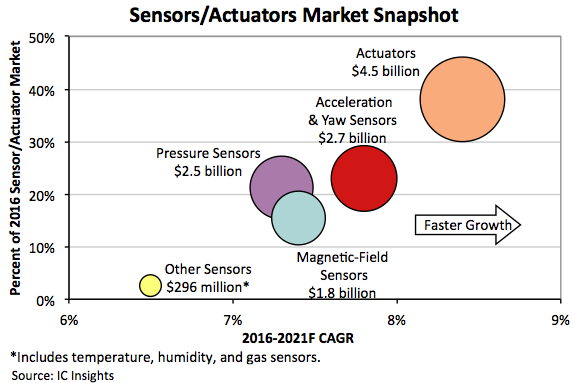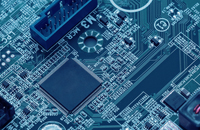Sensor/Actuator Sales Take Off As Price Erosion Eases
Strong unit growth continues to be driven by the spread of automated embedded controls, wearable systems, and the Internet of Things, says new O-S-D Report.
After several years of low and inconsistent growth rates primarily because of intense pricing pressure, the market for semiconductor sensors and actuators finally caught fire in 2016 with several of its largest product categories-acceleration/yaw and magnetic-field sensors and actuator devices-recording strong double- digit sales increases in the year, according to IC Insights’ new 2017 O-S-D Report-A Market Analysis and Forecast- for Optoelectronics, Sensors/Actuators, and Discretes.
In addition to the easing of price erosion, substantial unit-shipment growt in sensors and actuators continues to be fed by the spread of intelligent embedded control, new wearable systems, and the expansion of applications connected to the Internet of Things, says the 2017 O-S-D Report.
The new 360-page report shows worldwide sensor sales grew 14% in 2016 to a record-high $7.3 billion, surpassing the previous annual peak of $6.4 billion set in 2015, when revenues increased 3.7%. Actuator sales climbed 19% in 2016 to an all-time high of $4.5 billion from the previous record of $3.8 billion in 2015.
The 2017 O-S-D Report forecasts total sensor sales rising by a compound annual growth rate (CAGR) of 7.5% in the next five years, reaching $10.5 billion in 2021, while actuator dollar volumes are expected to increase by a CAGR of 8.4% to nearly $6.8 billion in the same timeframe. Figure 1 shows the relative market sizes of the five main product categories in the sensors/actuator segment, along with the projected five-year growth rates for the 2016-2021 forecast period.
The sensor/actuator market ended four straight years of severe price erosion in 2016 and finally benefitted from strong unit growth.
The average selling price (ASP) of sensors and actuators declined by -0.9% in 2016 versus an annual average of -9.3% during the four previous years (2012-2015), says IC Insights’ new O-S-D Report. All sensor product categories and the large actuator segment registered double-digit sales growth in 2016.
It was the first time in five years that sales growth was recorded in all sensor/actuator product categories, partly due to the easing of price erosion but also because of continued strong unit demand worldwide. Sensor/actuator shipments grew 17% in 2016 to a record-high of 20.3 billion units from 17.4 billion in 2015, when the volume
also increased 17%.

Figure 1
Strong 2016 sales recoveries occurred in acceleration/yaw-rate motion sensors (+15%), magnetic-field sensors and electronic compass chips (+18%), and the miscellaneous other sensor category (+20%) after market declines were registered in 2015. Sales growth also strengthened in pressure sensors, including MEMS microphone chips, (+10%) and actuators (+19%) in 2016.
The new O-S-D Report forecasts sales of acceleration/yaw sensors growing 9% in 2017 to about $3.0 billion, magnetic-field sensors (and compass chips) rising 8% to nearly $2.0 billion, and pressure sensors increasing 8% to $2.7 billion this year. Actuator sales are projected to grow 8% in 2017 to about $4.9 billion.
About 82% of the sensors/actuators market’s revenues in 2016 came from semiconductors built with microelectromechanical systems (MEMS) technology—meaning pressure sensors, microphone chips, acceleration/yaw motion sensors, and actuators that use MEMS-built transducer structures to initiate physical action in a wide range of devices, including inkjet printer nozzles, microfluidic chips, micro-mirrors, and surface-wave filters for RF signals. MEMS-built products represented 48% of total sensor/actuator shipments in 2016, or about 9.8 billion units last year.
MEMS-based product sales climbed 15.4% in 2016 to a record-high $9.7 billion after rising 5.1% in 2015 and 5.8% in 2014.
Some inventory corrections and steep ASP erosion in MEMS-built devices have suppressed revenue growth in recent years, but this group of products—like the entire sensors/actuator market—is benefitting from increased demand in new wearable systems, IoT, and the rapid spread of intelligent embedded control, such as autonomous automotive features rolling into cars. MEMS-based sensors and actuator sales are forecast to rise 7.9% in 2017 to $10.5 billion and grow by a CAGR of 8.0% in the 2016-2021 period to $14.3 billion, says the new O-S-D Report.
在线留言询价

Sensors, Blockchains Meet Tomatoes
- 一周热料
- 紧缺物料秒杀
| 型号 | 品牌 | 询价 |
|---|---|---|
| TL431ACLPR | Texas Instruments | |
| CDZVT2R20B | ROHM Semiconductor | |
| MC33074DR2G | onsemi | |
| BD71847AMWV-E2 | ROHM Semiconductor | |
| RB751G-40T2R | ROHM Semiconductor |
| 型号 | 品牌 | 抢购 |
|---|---|---|
| TPS63050YFFR | Texas Instruments | |
| BP3621 | ROHM Semiconductor | |
| BU33JA2MNVX-CTL | ROHM Semiconductor | |
| IPZ40N04S5L4R8ATMA1 | Infineon Technologies | |
| ESR03EZPJ151 | ROHM Semiconductor | |
| STM32F429IGT6 | STMicroelectronics |
- 周排行榜
- 月排行榜
AMEYA360公众号二维码
识别二维码,即可关注


请输入下方图片中的验证码:
























